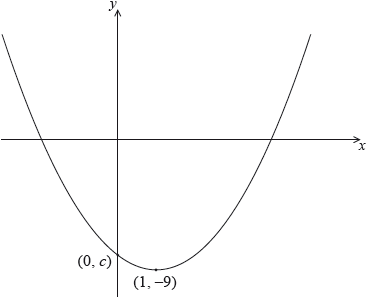Question
Let \(f(x) = 3{x^2} – 6x + p\). The equation \(f(x) = 0\) has two equal roots.
Write down the value of the discriminant.
Hence, show that \(p = 3\).
The graph of \(f\)has its vertex on the \(x\)-axis.
Find the coordinates of the vertex of the graph of \(f\).
The graph of \(f\) has its vertex on the \(x\)-axis.
Write down the solution of \(f(x) = 0\).
The graph of \(f\) has its vertex on the \(x\)-axis.
The function can be written in the form \(f(x) = a{(x – h)^2} + k\). Write down the value of \(a\).
The graph of \(f\) has its vertex on the \(x\)-axis.
The function can be written in the form \(f(x) = a{(x – h)^2} + k\). Write down the value of \(h\).
The graph of \(f\) has its vertex on the \(x\)-axis.
The function can be written in the form \(f(x) = a{(x – h)^2} + k\). Write down the value of \(k\).
The graph of \(f\) has its vertex on the \(x\)-axis.
The graph of a function \(g\) is obtained from the graph of \(f\) by a reflection of \(f\) in the \(x\)-axis, followed by a translation by the vector \(\left( \begin{array}{c}0\\6\end{array} \right)\). Find \(g\), giving your answer in the form \(g(x) = A{x^2} + Bx + C\).
Answer/Explanation
Markscheme
correct value \(0\), or \(36 – 12p\) A2 N2
[2 marks]
correct equation which clearly leads to \(p = 3\) A1
eg \(36 – 12p = 0,{\text{ }}36 = 12p\)
\(p = 3\) AG N0
[1 mark]
METHOD 1
valid approach (M1)
eg \(x = – \frac{b}{{2a}}\)
correct working A1
eg \( – \frac{{( – 6)}}{{2(3)}},{\text{ }}x = \frac{6}{6}\)
correct answers A1A1 N2
eg \(x = 1,{\text{ }}y = 0;{\text{ }}(1,{\text{ }}0)\)
METHOD 2
valid approach (M1)
eg \(f(x) = 0\), factorisation, completing the square
correct working A1
eg \({x^2} – 2x + 1 = 0,{\text{ }}(3x – 3)(x – 1),{\text{ }}f(x) = 3{(x – 1)^2}\)
correct answers A1A1 N2
eg \(x = 1,{\text{ }}y = 0;{\text{ }}(1,{\text{ }}0)\)
METHOD 3
valid approach using derivative (M1)
eg \(f'(x) = 0,{\text{ }}6x – 6\)
correct equation A1
eg \(6x – 6 = 0\)
correct answers A1A1 N2
eg \(x = 1,{\text{ }}y = 0;{\text{ }}(1,{\text{ }}0)\)
[4 marks]
\(x = 1\) A1 N1
[1 mark]
\(a = 3\) A1 N1
[1 mark]
\(h = 1\) A1 N1
[1 mark]
\(k = 0\) A1 N1
[1 mark]
attempt to apply vertical reflection (M1)
eg \( – f(x),{\text{ }} – 3{(x – 1)^2}\), sketch
attempt to apply vertical shift 6 units up (M1)
eg \( – f(x) + 6\), vertex \((1, 6)\)
transformations performed correctly (in correct order) (A1)
eg \( – 3{(x – 1)^2} + 6,{\text{ }} – 3{x^2} + 6x – 3 + 6\)
\(g(x) = – 3{x^2} + 6x + 3\) A1 N3
[4 marks]
Question
The following diagram shows part of the graph of a quadratic function \(f\).

The vertex is at \((1,{\text{ }} – 9)\), and the graph crosses the y–axis at the point \((0,{\text{ }}c)\).
The function can be written in the form \(f(x) = {(x – h)^2} + k\).
Write down the value of \(h\) and of \(k\).
Find the value of \(c\).
Let \(g(x) = – {(x – 3)^2} + 1\). The graph of \(g\) is obtained by a reflection of the graph of \(f\) in the \(x\)-axis, followed by a translation of \(\left( {\begin{array}{*{20}{c}} p \\ q \end{array}} \right)\).
Find the value of \(p\) and of \(q\).
Find the x-coordinates of the points of intersection of the graphs of \(f\) and \(g\).
Answer/Explanation
Markscheme
\(h = 1,{\text{ }}k = – 9\;\;\;\left( {{\text{accept }}{{(x – 1)}^2} – 9} \right)\) A1A1 N2
[2 marks]
METHOD 1
attempt to substitute \(x = 0\) into their quadratic function (M1)
eg\(\;\;\;f(0),{\text{ }}{(0 – 1)^2} – 9\)
\(c = – 8\) A1 N2
METHOD 2
attempt to expand their quadratic function (M1)
eg\(\;\;\;{x^2} – 2x + 1 – 9,{\text{ }}{x^2} – 2x – 8\)
\(c = – 8\) A1 N2
[2 marks]
evidence of correct reflection A1
eg\(\;\;\; – \left( {{{(x – 1)}^2} – 9} \right)\), vertex at \((1,{\text{ }}9)\), y-intercept at \((0,{\text{ }}8)\)
valid attempt to find horizontal shift (M1)
eg\(\;\;\;1 + p = 3,{\text{ }}1 \to 3\)
\(p = 2\) A1 N2
valid attempt to find vertical shift (M1)
eg\(\;\;\;9 + q = 1,{\text{ }}9 \to 1,{\text{ }} – 9 + q = 1\)
\(q = – 8\) A1 N2
Notes: An error in finding the reflection may still allow the correct values of \(p\) and \(q\) to be found, as the error may not affect subsequent working. In this case, award A0 for the reflection, M1A1 for \(p = 2\), and M1A1 for \(q = – 8\).
If no working shown, award N0 for \(q = 10\).
[5 marks]
valid approach (check FT from (a)) M1
eg\(\;\;\;f(x) = g(x),{\text{ }}{(x – 1)^2} – 9 = – {(x – 3)^2} + 1\)
correct expansion of both binomials (A1)
eg\(\;\;\;{x^2} – 2x + 1,{\text{ }}{x^2} – 6x + 9\)
correct working (A1)
eg\(\;\;\;{x^2} – 2x – 8 = – {x^2} + 6x – 8\)
correct equation (A1)
eg\(\;\;\;2{x^2} – 8x = 0,{\text{ }}2{x^2} = 8x\)
correct working (A1)
eg\(\;\;\;2x(x – 4) = 0\)
\(x = 0,{\text{ }}x = 4\) A1A1 N3
[7 marks]
Total [16 marks]
Question
The following diagram shows the graph of a function \(f\), for −4 ≤ x ≤ 2.
On the same axes, sketch the graph of \(f\left( { – x} \right)\).
Another function, \(g\), can be written in the form \(g\left( x \right) = a \times f\left( {x + b} \right)\). The following diagram shows the graph of \(g\).
Write down the value of a and of b.
Answer/Explanation
Markscheme
A2 N2
[2 marks]
recognizing horizontal shift/translation of 1 unit (M1)
eg b = 1, moved 1 right
recognizing vertical stretch/dilation with scale factor 2 (M1)
eg a = 2, y ×(−2)
a = −2, b = −1 A1A1 N2N2
[4 marks]
